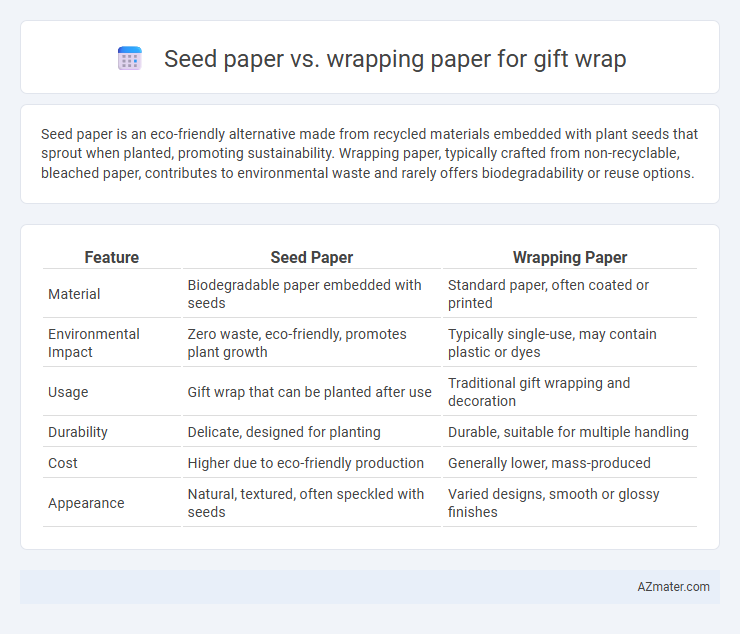Seed paper is an eco-friendly alternative made from recycled materials embedded with plant seeds that sprout when planted, promoting sustainability. Wrapping paper, typically crafted from non-recyclable, bleached paper, contributes to environmental waste and rarely offers biodegradability or reuse options.
Table of Comparison
| Feature | Seed Paper | Wrapping Paper |
|---|---|---|
| Material | Biodegradable paper embedded with seeds | Standard paper, often coated or printed |
| Environmental Impact | Zero waste, eco-friendly, promotes plant growth | Typically single-use, may contain plastic or dyes |
| Usage | Gift wrap that can be planted after use | Traditional gift wrapping and decoration |
| Durability | Delicate, designed for planting | Durable, suitable for multiple handling |
| Cost | Higher due to eco-friendly production | Generally lower, mass-produced |
| Appearance | Natural, textured, often speckled with seeds | Varied designs, smooth or glossy finishes |
Introduction: Eco-Friendly Gift Wrapping Choices
Seed paper offers a sustainable alternative to conventional gift wrap by embedding plant seeds into biodegradable paper that can be planted after use, reducing waste and promoting environmental regeneration. Wrapping paper, often made from non-recyclable materials and coated with plastics or glitter, contributes significantly to landfill overflow and environmental pollution. Choosing seed paper for gift wrapping supports zero-waste practices and enhances eco-conscious gifting with a message of sustainability and growth.
What is Seed Paper?
Seed paper is an eco-friendly, biodegradable material embedded with dormant seeds that can be planted after use, promoting sustainability and reducing waste. Unlike traditional wrapping paper, seed paper transforms into flowers, herbs, or vegetables when planted in soil and watered, making it a unique and environmentally conscious choice for gift wrap. Its texture and appearance are often handmade, enhancing the aesthetic appeal while supporting green living practices.
Understanding Traditional Wrapping Paper
Traditional wrapping paper is typically made from non-recyclable materials coated with dyes, plastics, and adhesives, which hinders environmental sustainability. It often ends up in landfills, contributing significantly to waste issues during festive seasons. In contrast, seed paper offers an eco-friendly option, embedding seeds within biodegradable fibers that can grow into plants after use.
Environmental Impact: Seed Paper vs. Wrapping Paper
Seed paper significantly reduces environmental impact by being biodegradable and plantable, allowing it to decompose naturally while growing seeds into plants. Traditional wrapping paper often contains plastic coatings or non-recyclable materials, contributing to landfill waste and increased carbon emissions. Choosing seed paper supports sustainable practices by minimizing pollution and promoting biodiversity through its eco-friendly composition.
Cost Comparison: Seed Paper and Conventional Wrap
Seed paper typically costs 10-15% more than conventional wrapping paper due to its eco-friendly materials and biodegradable properties. Conventional wrap is mass-produced, making it more affordable and widely available, with prices ranging from $0.50 to $2.00 per sheet, whereas seed paper ranges from $1.00 to $3.00 per sheet. Despite higher upfront costs, seed paper offers environmental benefits that can justify the price difference for sustainable gifting.
Aesthetics & Customization Options
Seed paper offers a unique, eco-friendly aesthetic with embedded plant seeds that promote sustainability and add a natural, textured appearance to gift wrap. Wrapping paper provides a wide range of vibrant colors, patterns, and finishes, allowing for extensive customization to match themes and occasions. While seed paper emphasizes organic beauty and environmental impact, wrapping paper excels in versatility and visual variety for personalized gift presentation.
Usability and Durability in Gift Wrapping
Seed paper offers eco-friendly usability with embedded seeds that can be planted after use, making it ideal for sustainable gift wrapping but may lack the durability for heavy or bulky items. Wrapping paper provides superior durability and ease of handling, typically made from stronger materials that resist tearing, ensuring secure and neat presentation for various gift sizes. Choosing between seed paper and wrapping paper depends on the balance between environmental impact and the need for robust protection during gift transport.
Biodegradability and Disposal
Seed paper offers superior biodegradability compared to traditional wrapping paper, as it breaks down naturally and can even be planted to grow flowers or herbs, reducing waste and promoting sustainability. Wrapping paper, especially those coated with plastic or metallic finishes, often resists decomposition and contaminates recycling streams, making disposal more problematic and environmentally harmful. Opting for seed paper supports eco-friendly gift wrapping by minimizing landfill impact and encouraging a circular lifecycle through natural decomposition and plant growth.
Creative Gift Presentation Ideas
Seed paper offers an eco-friendly and innovative gift-wrapping option that enhances creative gift presentation by allowing the wrapping to be planted and grown into flowers or herbs, adding a meaningful and sustainable touch. Wrapping paper provides a versatile and visually appealing choice with diverse textures, colors, and patterns that can be tailored to match the gift theme and recipient's personality. Combining seed paper with decorative elements like ribbons or personalized tags elevates the unwrapping experience, making the presentation memorable and environmentally conscious.
Conclusion: Choosing the Best Gift Wrap for Sustainability
Seed paper promotes sustainability by embedding biodegradable seeds that grow into plants, reducing waste and supporting environmental regeneration. Wrapping paper varies in sustainability depending on material composition, with recycled or reusable options offering lower ecological impact than conventional, non-recyclable variants. Selecting seed paper or recycled wrapping paper enhances eco-friendly gift wrapping by minimizing landfill contributions and encouraging green practices.

Infographic: Seed paper vs Wrapping paper for Gift Wrap
 azmater.com
azmater.com